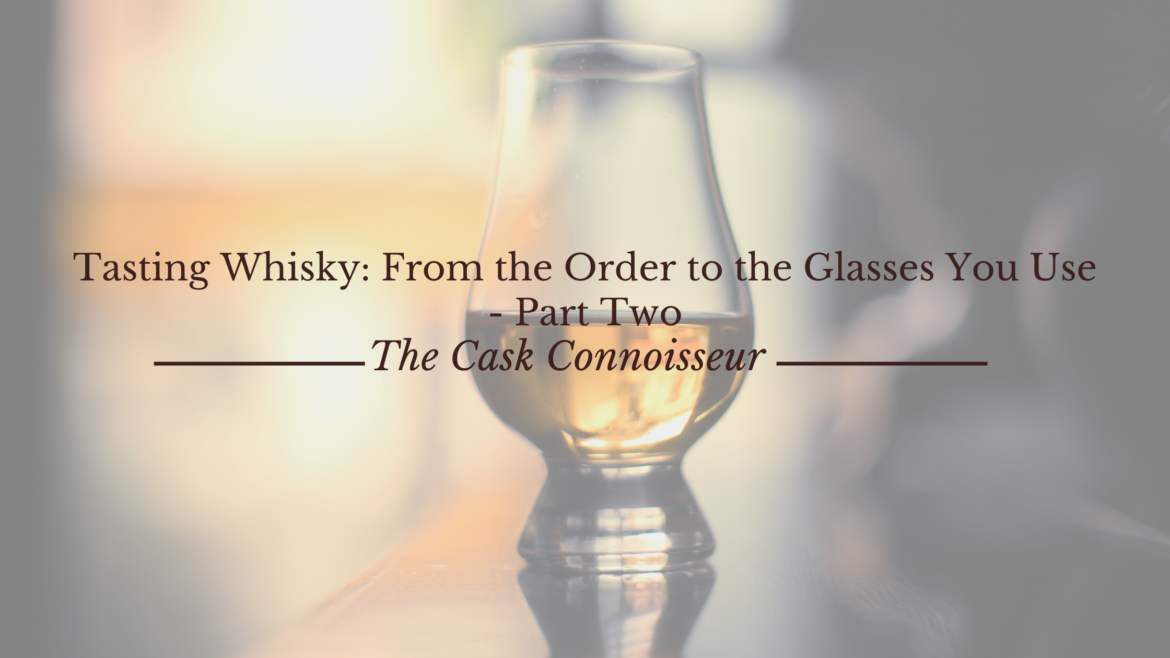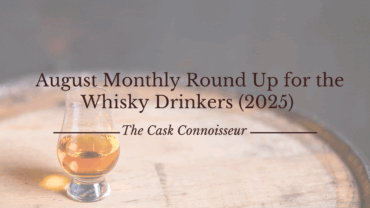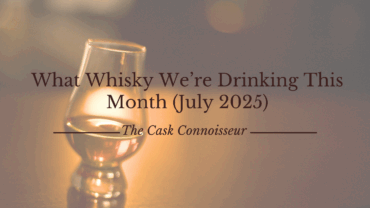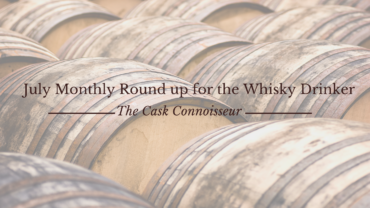We previously shared our thoughts on tasting whisky, but here are some additional thoughts that Chris Walster, our in-house whisky expert has put together.
You need to look at the colour, this will indicate possible flavours and varies depending on the cask used and the length of time the whisky has been in the cask. First fill casks of any description will always have stronger/darker colour than refill casks. Older whiskies will also extract more colour from the cask. New make spirit is always clear with all the colour (unless colouring has been added by the distiller) coming from the maturation cask. It is always interesting guessing what cask or casks the whisky has matured in.
Swirl the glass
This helps release the nose and also lets you examine the legs. Legs are formed by how the whisky coats the glass as you swirl it. They can be thick or thin, slow or fast, more visible or less visible. Thick, visible and slow legs suggest the whisky will be oily on the palate, giving a fuller coating to your palate as you swirl it around your mouth. Thin or runny legs tend to suggest a lighter whisky that is not full flavoured.
Nose the whisky
Everyone has their favourite way of nosing. This might be holding the glass close to the nose and inhaling, or holding it away from the nose and using your hand to waft the aromas towards your nose and inhaling. Holding your hand over the glass for a few seconds before nosing can help capture the aromas. My preferred method is to hold the glass close to one nostril and inhale. Then repeat with the other nostril. That way, I minimise any alcohol burn and get two attempts at deciphering what can sometimes be a complex bouquet of aromas.
Allow your nose to “rest” and repeat as often as necessary. Think about what you are smelling and start with “naming” the bolder aromas and then try to split them up and separate them out to help pick out each aroma from the complex. Discuss with other tasters what you can smell. This will help identify the aromas but beware it can convince you of aromas that were never there, or at least you could not find them. It is worth remembering that there is considerable variation between people on what aromas they get from a whisky.
An interesting variation on nosing is to inhale with your mouth closed and then with your mouth open. You will notice that what aromas you can detect are different. I’m not sure what physiological mechanism causes this variation, and would be interested to hear if you know, but presume it illustrates how taste and smell are interconnected senses.
Take the first sip
Having looked at the colour, the legs and nosed the whisky, now is the time to take the first sip. Try it neat even if it’s cask strength. Swirl it around your mouth and try identifying the flavours. Although not necessary, it can be useful to swirl it around for one second of each year of maturation. This can be helpful in exploring the full flavour profile. Remember that the distillery or bottler has already tried the whisky and decided it is at its best at whatever ABV. Adding water may make the whisky taste better but can make a huge difference to the nose, palate and finish. The ABV may not be your personal preference but remember the old adage that you can always add water, but you cannot take it away.
Having tasted it neat, you now should add water. The amount to add is up to you, but I usually add no more than five drops. This is unlikely to change the ABV but will most likely change the aromas, flavours, and finish. Sometimes it makes no apparent difference, sometimes it can improve the whisky and other times you might wish you hadn’t added water. But this is all part of the tasting process.
The finish is the last thing to note. Finishes are the flavours and feelings in your mouth after swallowing the whisky. Finishes are often described as short, medium, or long as well as any flavours left in your mouth such as fruits, chocolate, coffee, peat/smoke, spiciness and wood etc. A rule of thumb is that whiskies with long finishes are better, but everyone has their personal preference.
Complete your notes
Once finished, complete your notes, and score the whisky say out of ten or on the nose, palate and finish. Keeping consistent on how you taste the whisky during the flight, so you are comparing like to like as much as possible. At some point you will want to know what the official notes are. Whether you read them during tasting the whisky and then compare what you find to the official notes, or whether you read them after the tasting is up to you. On the one hand it can be useful knowing the official notes in helping tease out the nuances, on the other you’ll be amazed at how knowing the official notes will alter your perception of the whisky. Sometimes you’ll wonder whether the official taster was drinking the same whisky as you or whether the marketing department had got a bit over-enthusiastic.
Because knowing the distillery, the colour, legs and official notes can significantly change for the better or worse how you experience the whisky it can be fun to carry out a blind tasting. This can be easily done by covering up the bottle, taking it further includes using opaque glasses and even blindfolding, only revealing the bottle label after the tasting. You will find it quite hard to identify much more than the style of the whisky (e.g. Campbelltown or Highland). Very hard to identify the distillery and feel very pleased with yourself if you identify the style, casks used, distillery and finishing casks. Even the most experienced whisky drinker will struggle and often get it wrong. This just demonstrates how sight, smell and taste are all interconnected and that experiences and the environment you’re in, all influence your interpretation of the whisky.
Variations on a theme for tastings are to pair the whisky with cheese or chocolate, both of which go well with whisky. These types of tastings are much harder to organise, as you will need to try the whisky and food before the tasting to get the best results. From experience pairing the right cheese or chocolate with a whisky can be sublime, but I’ve yet to figure out a fool-proof way of pairing, it is not as simple as the internet would have you think. Another interesting variation is to have a tasting of different cask finishes and pair the whisky with the actual spirit used in the finish.






1Comment
April 20, 2023 at 8:01 am